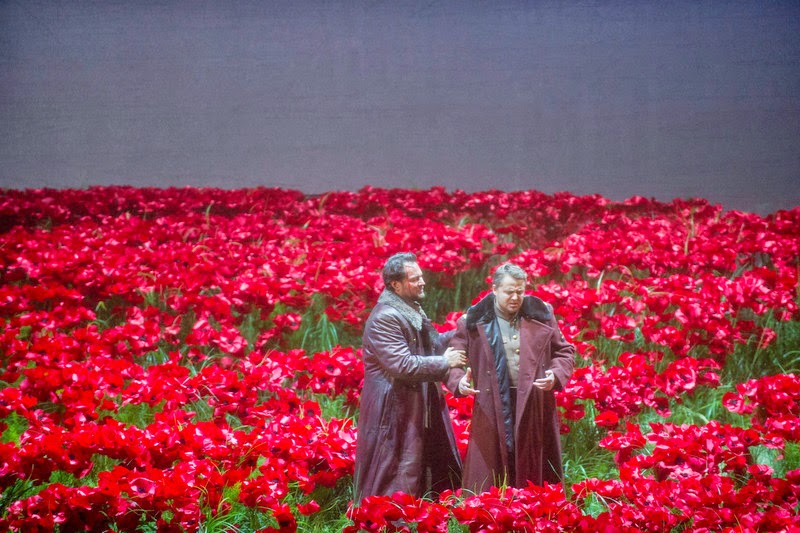Company of Persée. Photo by Bruce Zinger
Reviewed by James
Karas
How do you bring an opera that premiered in 1682 and was staged in a
revised version in 1770 for a royal wedding to full and glorious life? Remember
production methods were very different then and the opera reflects its 17th
century values and is rather static at times.
If the opera is Lully’s Persée, just give it to Opera
Atelier and its Co-Artistic Directors Marshall Pynkoski and Jeannette
Lajeunesse Zingg and they will deliver a production that is simply well-sung,
colourful, stylized and, in a word, brilliant.
Persée is based on the myth of Perseus and Andromeda
(I will stick to the English version of all the names) who are in love but have
a few impediments to deal with. The toughest one is the once beautiful Medusa
who has been turned into a snake-haired monster. One look by her and you are
turned into a stone.
Everything good and ill is brought about by the gods. Perseus has
friends on Olympus including Jupiter who happens to be his father. With
considerable help from the immortals, Perseus will try to kill Medusa. The
story is a bit convoluted so let’s not worry too much about the plot outline.
Beside, a god will come down from the sky at the end and set everything right.
Pynkoski and Set Designer Gerard Gauci deliver a brilliantly colourful
production. From the costumes to the sets, to the monsters, to the deus ex machina, we are treated to a
dazzling array of colours. There are scenes in the royal palace of Ethiopia,
the bleak cave of Medusa and the gorgons, and the seacoast that have vibrant
and flamboyant sets.
Choreographer Zingg provides a veritable ballet interspersed throughout
the opera. The artists of the Atelier Ballet never fail to enhance the action
of the opera especially when there is the smallest suggestion that the
performance may become static.
True to the principles of Opera Atelier, the performance is stylized as
it may have looked in the time of Louis XIV. Arms up, bent at the elbows with
palms facing forward, the torso bent slightly to the side is one of the
classic, stylized positions. This is not an opera that calls for naturalistic
acting and Pynkoski makes extensive use of baroque conventions.
The above-noted aspects of the production may be considered as of
secondary importance in many productions, but I think they play a primary role
in this Persée. You can have good
singers and a fine orchestra and fall short of the quality of this production
without the elements provided by Pynkoski and Zingg.
The singing ranged from the exceptional to the adequate. Sopranos
Mireille Asselin as Andromeda, Peggy Kriha Dye as Merope and Carla Huhtanen as
Queen Cassiopeia did excellent work in their respective roles. I would have
preferred a tenor with a lighter voice for the role of Perseus but Christopher
Enns managed to be sufficiently heroic and vocally adept to carry the role of
our hero.
Phineus is the human heavy of the opera (he too is in love with
Andromeda and wants to jettison Perseus to Hades) and baritone Vasil Garvanliev
did a fine job in the role.
Bass-baritone Olivier LaQuerre sounded a bit stilted as King Cepheus and
was wooden as Medusa. Pynkoski treats the scene with the monster as outright
burlesque but LaQuerre was only partially successful in the part.
The Tafelmusik Baroque Orchestra under David Fallis and the Tafelmusik
Chamber Choir performed brilliantly.
This is Baroque opera at its finest and it is no wonder that the next
stop of the production will be the Royal Opera House in Versailles. It should
prove a great lesson for the French on how to produce French opera. Only in
Canada, eh?
____
Persée by Jean-Baptiste Lully with libretto by
Philippe Quinault opened on April 26 and
will run until May 3, 2014 at the Elgin Theatre, 189 Yonge Street, Toronto,
Ontario. www.operaatelier.com




